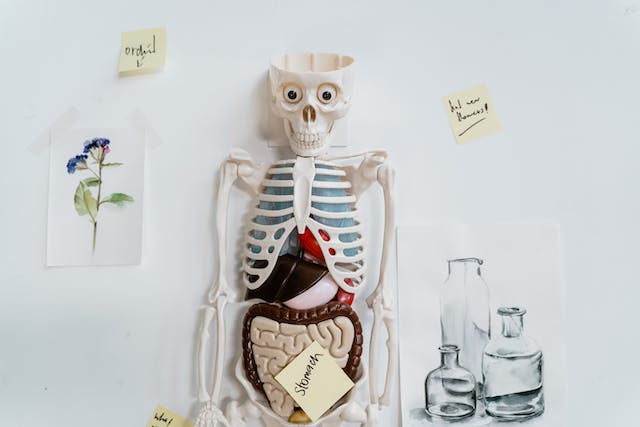
How do our organs stay where they are when we stand up? Pieces of tissue called fascia hold our organs in place, along with a membrane called the serous membrane.
I need to define this question a little more succinctly because organ has a surprisingly broad definition. The Oxford English Dictionary defines “organ” as “a part of an animal or plant body that serves a particular physiological function.” Wikipedia says that there are 79 organs in the human body. They define an organ as “a collection of tissues joined in a structural unit to serve a common function.” By these definitions, the skeleton is an organ, as is the mouth, and our bone marrow. To be clearer, I want to know how our major internal organs, the ones generally in our torso, stay where they are when we stand up. Let’s look at our brain, heart, lungs, liver, stomach, intestines, and bowel.
The brain is obviously kept in place by the skull. However, it is not completely held in. There is a space of about 2 mm between the brain and the skull, depending on the person and the area of the brain. Between the brain and the skull is something called the meninges. The word meningitis comes from because it is an infection of the meninges. There are three parts to the meninges. The first is the dura mater, which lines the inside of the skull and has folds that contain different parts of the brain. The second is the arachnoid, which is a loose membrane that covers the brain with some space under it. Finally, the pia mater is a membrane that tightly encloses the brain. The space between the arachnoid and the pia mater is filled with cerebrospinal fluid. All of this serves to cushion and hold the brain in place, but it can still move slightly. And, if we have an accident, it can move and twist enough to cause concussion and brain damage.
The internal organs in our torso are also able to move slightly, but they are generally held in place. Some organs are fastened more securely than others. They are held in place by four different things. Firstly, they are all connected to blood vessels that frame them and don’t move a lot, although they can stretch a little and organs can move within them. Secondly, they are held in place by the body fat and muscles that surround them a fill the torso. Thirdly, they are held in place by the other organs. They support each other. Fourthly, they are contained by a membrane called the serous membrane. And, fifthly, they are mostly attached to the abdominal cavity and the other organs with ligaments called fascia.
The fascia ligaments are the main reason why our organs don’t slide all over the place. They attach the organs to the insides of the body with large pieces. They also surround the organs in layers of connective tissue. However, they don’t hold the organs rigidly and they can move. When we lie down, the direction of gravity obviously changes and the internal organs will ever so slightly swing in that direction. I say ever so slightly, because the organs are large and there is not a lot of empty space inside the abdominal cavity. What space isn’t taken up with organs is filled with fat, blood vessels, tendons, and muscles. Organs can move, but not a huge amount. There is no risk that they will get twisted. When we stand up, they slide back into the usual position. The intestines can move a little more because they are very long and not completely connected. Throughout the day they can very gradually sink down into the pelvis.
When people are in space, the lack of gravity can have a slight impact on the position of the organs, but not a lot because the space inside the body hasn’t changed. Zero or low gravity can affect the body in many other ways, but organ position is not one of them. People can become space sick because the inner ear can’t balance as well when there is no gravity. This produces a feeling similar to seasickness. Blood and bodily fluids are not pulled down by gravity as they would be on Earth and they can accumulate in the upper body, Bones and muscles can weaken and deteriorate. The effects on the inner organs are minimal though. And this is what I learned today.
Photo by MART PRODUCTION: https://www.pexels.com/photo/skeleton-model-and-sticky-notes-8471784/
Sources
https://humans-in-space.jaxa.jp/en/life/health-in-space/body-impact/
https://en.wikipedia.org/wiki/List_of_organs_of_the_human_body
https://www.medicinenet.com/how_many_organs_are_there_in_the_body/article.htm
https://www.oed.com/search/dictionary/?scope=Entries&q=organ
https://my-ms.org/anatomy_brain_protect.htm
